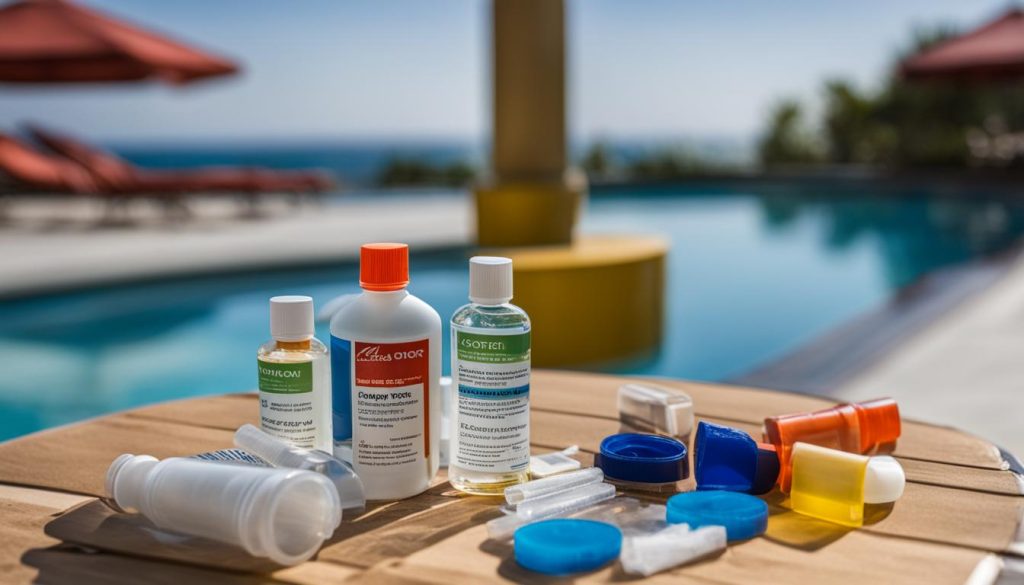As pool owners, we all want to ensure a safe and enjoyable swimming experience for ourselves, our families, and our guests. However, achieving and maintaining optimal water quality is a crucial aspect of this goal that cannot be overlooked. That’s where pool water testing comes in.
Regular testing of your pool water is essential to identify any imbalances or potential issues before they become major problems. Neglecting pool water testing can lead to cloudy, unpleasant water, chlorine smell, and even potential health hazards.
In this section, we will delve into the importance of pool water testing and how it contributes to maintaining ideal water quality for a safe and healthy swimming experience.
Key Takeaways
- Pool water testing is crucial for maintaining safe and enjoyable swimming conditions.
- Neglecting pool water testing can lead to unpleasant water and potential health hazards.
- Regular testing can help identify imbalances and issues before they become major problems.
- Maintaining optimal water quality requires a thorough understanding of pool water chemistry
- Different methods exist for testing pool water, including test strips, liquid test kits, and digital readers.
Why Regular Pool Water Testing is Crucial for Maintaining a Clean and Safe Swimming Environment
With substantial experience in fiberglass, vinyl, or concrete pool installations, at Pool Installers, we highlight the crucial importance of routinely testing your pool water. Neglecting water testing can adversely affect the overall quality of your pool water, presenting potential dangers to swimmers.
Without proper maintenance, the water in your pool can become a breeding ground for harmful bacteria, leading to infections and illnesses. Additionally, poorly balanced pool water can damage your pool equipment, causing costly repairs and replacements.
By testing your pool water regularly, you can prevent these issues and ensure that your pool is safe and healthy for everyone to enjoy. Not only does it provide peace of mind for pool owners, but it also helps to maintain the longevity of the pool and equipment.
But how often should you test your pool water? It’s recommended to test your water at least once a week during the swimming season, and every other week during the off-season. However, if you notice any sudden changes in the water’s appearance or smell, it’s best to test it immediately.
As you can see, regular pool water testing is not something that should be overlooked. By taking the necessary steps to maintain optimal water quality, you can ensure a safe and enjoyable swimming experience for everyone.
Understanding Pool Water Chemistry
When it comes to maintaining optimal pool water quality, it’s crucial to have a basic understanding of pool water chemistry. There are several factors that contribute to the overall chemical makeup of your pool water, and it’s important to monitor these levels regularly through pool water testing.
One of the key chemical levels to monitor is pH. The pH level measures the acidity or alkalinity of your pool water on a scale of 0-14. Ideally, your pool water should have a pH between 7.2 – 7.8. If the pH level is too low, the water is acidic and can cause skin and eye irritation. If the pH level is too high, the water is alkaline and can lead to cloudy water and scale buildup.
Chlorine is another important chemical level to monitor in your pool water. Chlorine is a powerful disinfectant that helps to kill bacteria and other harmful microorganisms in the water. The ideal range for chlorine is between 1-3 parts per million (ppm). If the chlorine level is too low, the water can become a breeding ground for bacteria and algae. If the chlorine level is too high, it can cause skin and eye irritation.
Alkalinity is also a crucial factor in maintaining proper water chemistry. Alkalinity measures the ability of the water to resist changes in pH levels. The ideal range for alkalinity is between 80-120 ppm. If the alkalinity level is too low, the pH level can fluctuate rapidly. If the alkalinity level is too high, it can make it difficult to adjust the pH level.
Other chemical levels to monitor include calcium hardness, cyanuric acid, and total dissolved solids (TDS).
As you can see, there are several chemical levels to monitor in your pool water to maintain optimal water quality. Regular pool water testing is the key to ensuring that these levels are within the ideal range. In the next section, we’ll dive into the different methods for testing your pool water and interpreting the results accurately.
How to Test Your Pool Water
Now that we understand why pool water testing is essential and the importance of maintaining balanced pool water, let’s dive into the different methods for testing your pool water.
Test Strips
Test strips are the most commonly used method for testing pool water because they’re easy to use and provide quick results. To test with strips, dip the strip into the pool water for a few seconds and then compare the colors on the strip to the chart provided on the packaging. Different strips may test for different chemical levels, so make sure to get strips that test for pH, chlorine, and alkalinity at a minimum.
Liquid Test Kits
Liquid test kits are another popular method for testing pool water. They involve using drops of liquid reagents to test for chemical levels in the water. Liquid test kits are generally more accurate than test strips, but they can also be more time-consuming and require more steps. Follow the instructions provided with the kit carefully to ensure accurate testing and interpretation of results.
Digital Readers
Digital readers are the most expensive testing method, but they provide the most accurate results. They work by using sensors to detect chemical levels in the water and then display the results digitally. While they’re easy to use, they require regular maintenance and calibration to ensure accurate results.
| Testing Method | Pros | Cons |
|---|---|---|
| Test Strips | Easy to use, quick results | Less accurate than other methods |
| Liquid Test Kits | More accurate than test strips | More time-consuming, requires more steps |
| Digital Readers | Most accurate results | Expensive, requires regular maintenance |
Regardless of which method you choose, it’s important to test your pool water regularly and maintain balanced chemical levels to ensure a safe and healthy swimming environment.
Maintaining Balanced Pool Water
After testing your pool water, it’s essential to maintain balanced pool water to ensure a safe and healthy swimming environment.
The following table outlines the recommended ranges for chemical levels in your pool water:
| Chemical | Recommended Range | Ideal Range |
|---|---|---|
| pH | 7.2-7.8 | 7.4-7.6 |
| Chlorine | 1-4 ppm | 2-4 ppm |
| Alkalinity | 80-120 ppm | 100-120 ppm |
| Cyanuric Acid | 30-50 ppm | 30-50 ppm |
Keep in mind that these ranges may vary depending on factors such as climate, pool usage, and equipment.
If any of your test results fall outside of the recommended ranges, adjustments will need to be made to bring the water back into balance.
For pH levels that are too high, add an acid such as muriatic acid or sodium bisulfate. If the pH is too low, add baking soda or soda ash.
If the chlorine levels are too high, consider diluting the water by draining some and adding fresh water. If the levels are too low, add more chlorine to the pool.
In addition to chemical adjustments, make sure to regularly skim and vacuum your pool to prevent dirt and debris buildup, which can affect water quality.
By maintaining balanced pool water, you’ll enjoy a clean and safe swimming experience all season long.
Troubleshooting Common Water Quality Issues
At times, despite regular pool water testing and maintenance, you may encounter common water quality issues. Thankfully, troubleshooting these problems can be straightforward with the right tools and techniques.
Cloudy Water
Cloudy water can be due to a variety of factors, including improper filtration, poor water balance, or high levels of organic matter. Begin by testing your water to ensure that the chemical levels are within the recommended range. If the levels are appropriate, check your pool’s filtration system to ensure it is working correctly and clean the filters if necessary. If cloudy water persists, consider using a pool clarifier or seeking professional assistance.
Algae Growth
Algae growth is a common problem, especially in warm and sunny weather conditions. To prevent algae growth, ensure your pool water chemistry is balanced, and your pool is routinely brushed and vacuumed to remove debris. If algae have already taken hold, shock your pool with a high dose of chlorine and brush the affected areas. Remember to filter out the dead algae and follow up with regular water testing and maintenance to prevent future growth.
Excessive Chlorine Smell
An overpowering chlorine smell can indicate that the levels are too high. Begin by testing your water to confirm the levels and adjust as needed. If chlorine levels are within the recommended range, consider using a non-chlorine shock treatment or diluting your pool water with fresh water. If you’re struggling to maintain proper chlorine levels, trying a different disinfectant like bromine may be worth considering.
With these troubleshooting tips and regular pool water testing, your pool can maintain optimal water quality for a safe and enjoyable swimming season.
FAQ
Why is regular pool water testing important?
Regular pool water testing is important because it helps maintain a clean and safe swimming environment. Testing allows you to monitor the chemical levels in your pool, such as pH and chlorine, and ensure they are within the optimal range for a healthy swimming experience.
What are the potential dangers of neglecting water testing?
Neglecting water testing can lead to imbalanced chemical levels in your pool, which can result in various issues such as cloudy water, algae growth, and even skin and eye irritation for swimmers. It’s important to regularly test your pool water to prevent these problems and maintain optimal water quality.
What factors influence pool water quality?
Several factors influence pool water quality, including pH, chlorine levels, alkalinity, and other chemical balances. Understanding and monitoring these factors is essential for maintaining balanced pool water and a safe swimming environment.
How do I test my pool water?
There are different methods for testing your pool water, including test strips, liquid test kits, and digital readers. Follow the instructions provided with your chosen testing method to collect a sample of your pool water and then use the testing tools to measure the various chemical levels. The results will help you determine if any adjustments are needed.
How do I maintain balanced pool water?
To maintain balanced pool water, you need to ensure that the pH, chlorine, alkalinity, and other chemical levels are within the optimal range. This may require adding or adjusting chemicals as needed. Refer to the recommended ranges for each chemical and follow the instructions provided with your pool maintenance products for proper application.
What can I do if I encounter water quality issues?
If you encounter water quality issues such as cloudy water, algae growth, or excessive chlorine smell, regular pool water testing can help identify the problem. By monitoring the chemical levels and adjusting them accordingly, you can address and prevent these issues. Refer to our troubleshooting tips in Section 6 for more detailed solutions.

